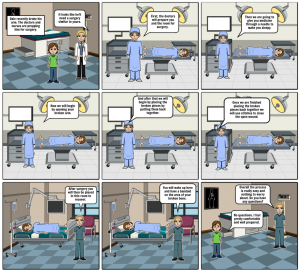Danielle Commodari
Chris Fenzel
Jackie Ndayizeye
Laura Rentz
Proposal:
Intro/Purpose
Our idea is to create a virtual reality experience that involves the medical field. Our objective is to make it easier for children to understand what is going to happen to them, before going into surgery. Families and children will benefit from this product because it will allow the children to be less anxious and scared prior to their procedure. The children will have a better understanding of the procedures that will be performed by the medical staff. In addition, the product will incorporate games, videos, and authentic pictures that will display through a virtual reality headset that will be able to help the medical team explain to children the entire process. For example, a study done by Phoenix Children’s Hospital showed that children who are more aware of what is going to happen, will have less anxiety and experience less pain, especially during the recovery process (“Effects of Virtual Reality on Preoperative Anxiety and Education of Anesthesia in Children and Adolescents”). This can be beneficial for children who are undergoing surgery. Therefore, this product should be considered by children’s hospitals and other pediatric offices that perform operations on young children.
The primary audience for this product is children’s hospitals because they can receive the greatest benefit from this type of resource. Having this type of virtual reality could greatly benefit children and lower their anxiety levels before surgery. In addition, larger organizations such as hospitals, clinics, and emergency rooms will be able to afford this tool and use it in multiple circumstances. A secondary audience would be doctors’ offices that perform minor surgeries. Overall, the product would greatly benefit the medical field by improving the process of explaining medical procedures to anxious kids before surgery.
Learning Outcomes
Virtual Reality has been proven to result in positive emotions. Dr. Jason M. Harley, from the Association for Education Communications and Technology, performed a test to discover the emotional effects of Virtual Reality, and the results were positive. In the independent group, he took 31 undergraduate students from a large university and had them learn historical lessons through virtual reality. He states in his report that “31 out of 31 undergraduate students gave positive feedback and gave only positive emotions, optimistic was the main emotion” (Harley). The students were given a history lesson and taught the same lesson in two ways, through augmented reality (computer, phone, and digital simulations) and Virtual Reality. The students then gave their feedback on which type of lesson they preferred to be taught, and they were asked why. The study demonstrated that virtual reality helped to alleviate the stress of college students generating positive feedback from them.
In addition to Virtual Reality being proven that it results in positive emotions, it can also increase surgical efficiency allowing children to become more comfortable with the procedure. The application will allow surgeons to make sure that the surgery is effective without any complications. Moreover, we are sure that the simulation will work and bring positive outcomes because of similar tests that were done to test the effects of surgical efficiency. At the Imperial College of London, Dr. Laura Beyer-Berjot had both novice surgeons and experienced surgeons do a laparoscopic appendectomy in virtual reality. The goal was to test the accuracy of virtual reality in an operating room to use for beginning surgeons for training. The surgeons were divided between novice and experienced and were tested on the amount of time it took to remove the appendix. Between them, the surgeons had a P score (performance score) of .026 and took the novice surgeons 282 seconds and the experience surgeons 259 seconds. After several trials, she concluded that “this type of training has demonstrated its positive impact for basic laparoscopic skills in the OR” (“Surgical training: Design of a virtual care pathway approach”). This test proves that Virtual Reality in the operating room can help train inexperienced surgeons but can also be used to show children what will be going on in the surgery to become more comfortable with what is happening.
The idea is to have medical staff walk patients through a simulation using the PlayStation VR, so the child can see what is going on. The goal is to give the child a better understanding and have them be more comfortable with going into surgery. Along with the feedback method proposed by Dr. Harley, the same method will be used to determine the effectiveness of our product. Through a survey both preoperative and postoperative, kids will judge how comfortable they feel and will have felt after both the virtual reality simulation and the actual surgery. In addition, to make the simulation as best as it can be, adjustments will be made based on any negative comments.
User experience/user interface
When children undergo any kind of procedure, they can feel incredibly anxious not knowing what to expect. Hospitals try their best to educate children and families of what to expect when going to the hospital. Since technology is evolving, more hospitals have equipment and funds that will help further educate children and families of what to expect in a hospital and during an operation through Virtual Reality. If a child must undergo surgery, there are many ways to prepare for their surgery that are slightly different than our Virtual Reality idea.
With research, Kidshealth.org suggests the best way to help prepare children for surgery is by explaining what will happen by reading books and informing children in a way that they will understand comfortably. This way, the hospital doesn’t seem as threatening (“Preparing your Child for Surgery”). The tone used when presenting the information to children is extremely important to prevent them from becoming fearful.
Both KidsHealth organization and the Children’s Hospital of Philadelphia agree that another way for children to prepare for surgery is through preoperative family orientation and hospital tours which are led by nurses and licensed child-life specialists. They are trained professionals ready to walk through and talk to kids about medical procedures they will undergo (Dowshen; “Preparing your Child for Surgery”). It’s always reassuring to hear someone talk and go through what is to be expected, but it doesn’t give the same effect as experiencing the procedure.
With technology evolving, we explore different ways of educating people with Virtual Reality experiences. Stanford Medicine provides information on Virtual Reality as it’s used to help alleviate pain and anxiety before children undergo surgery. Lucile Packard Children’s Hospital is one of the first hospitals that will begin to implement distraction-based VR therapy for patients, such as Blaine Baxter. This VR application is a way for children to become more comfortable with surgery distracting them with games from a more therapeutic VR application. “The VR was a game changer for Blaine. As soon as he put the goggles on, sedation was no longer needed” (Kate Detrempe), since Blaine Baxter had suffered from an arm injury. Blaine mother, had mentioned, “He would immediately start crying and screaming out of fear, and had to be sedated before doctors could approach his arm”. With the VR application, Blaine’s mind was completely distracted by the games that made it seem like he was actually there. For example, Blaine was able to swim under the sea, zap flying cheeseburgers in outer space, and even fly on paper airplanes through the sky. The VR has helped Blaine ease his feelings of pain and anxiety.
According to the article, “Development of a Virtual Reality Exposure Tool as Psychological Preparation for Elective Pediatric Day Care Surgery: Methodological Approach for a Randomized Controlled Trial”, it expresses that they expose children to all aspects of an operation room which will prepare children psychologically for surgery that is very similar to our Virtual Reality (Eijlers).
Since talking about different ways of preparing for surgery, our team has constructed an idea that will allow the preparation for surgery through Virtual Reality. In this Virtual Reality application, one can do almost just about everything as other hospitals are doing in preparation for surgery. We will be able to educate children before surgery while relieving their pain and reducing their anxiety. Our VR application is different from other Virtual Reality applications because children will be able to see what the doctors would be doing during their surgery. Children would then get a better understanding of what to expect. This is so much more informative than reading documents and telling patients and their families what is going to happen.
Implementation Strategy
Our virtual reality application will be implemented for quite some time. Also, the main difference is that it is more interactive with children by including activities that will take place before their surgery. In order for children to have the experience, it is imperative that we start recording many different medical scenarios that will be able to help them in understanding the procedure. Our Virtual Reality targets children between the ages of 6 and 18 and we have chosen a PlayStation VR, because it is less bulky and intimidating. The PlayStation VR will appear more kid-friendly and something they would be familiar with as it looks like something that would be in their own home. The PlayStation VR is completely affordable for hospitals to have several at a time as it only would cost them around $200 to $500. We will market by visiting hospitals and doing a demonstration of our product to them to show them how our product is very beneficial. To advertise our product, it could also be shown on Facebook since many parents are likely to use it. We will have a professional-looking model that will entice the hospitals to buy and use our Virtual Reality experience.
Long-term Vision
Our initial prototype will include a Virtual Reality experience for young children, especially between the ages of 6 and 18. Our Virtual Reality will include information and games that will help children understand what is going to happen throughout the duration of their procedure. This will allow us to focus on ways to improve the experience for preoperative children. The Virtual Reality will make it easier for young children to understand what is going on in the medical field because it will use language familiar to them. They will be able to play games that will make them feel like they are helping the doctors and medical professionals undergo the surgery. For example, the children will be able to be inside the room and be able to hear and feel compared to the actual surgery room. For some common pediatric surgeries will first be developed to allow us to focus on a small portion of this idea. Common surgeries, as stated by Rosenfeld that would be possible for Virtual Reality, are appendectomy (for children with appendicitis) and tonsillectomy (for children who need their tonsils removed) (“15 Most Common Types of Pediatric Surgery”). In the first stage of this prototype, these surgeries will be available to children who are undergoing basic medical procedures.
The next stage of this Virtual Reality development, more sections will be made, for a wider range of ages. The focus will be on children who are 5 years old and below. It will be able to explain to them, in a very basic way, of the procedure that’s going to be done to them. The Virtual Reality experience, will include interactive stories with children who are undergoing surgery. It is important to have it more fun and basic for them, so they won’t be as scared prior to their surgery. Again, only a few very common surgeries will be made in the beginning, to allow the focus to be on the quality. As it mentions in KidsHealth.org, “it is important for younger kids to understand what is going to happen and clear up any confusions because they will be less scared and more cooperative with the medical staff” (Rosenfeld). Younger children will especially benefit from this type of invention.
Another long-term stage of this Virtual Reality experience will provide a greater variety of pediatric surgeries. That will include a greater amount of rare surgeries that children are going to receive. It can also include a section that will teach parents on how to act around their children before and after their operation. This is also beneficial to parents since they would also be worried and anxious about their children’s surgical experiences. The future for Virtual Reality being used in this way is endless. As time progresses, a new medical technology will be created, and Virtual Reality could be easily updated to match what is being used in the children’s hospitals and doctor’s offices on a daily basis.
Works Cited
Buyuk, Tural, et al. “Original Article: An Analysis of the Anxiety Levels of Mothers Who Participate in Education and Therapeutic Games About Their Children’s Surgeries.” ScienceDirect, Elsevier Inc., 2017, ezproxy.stevenson.edu/login?url=http://search.ebscohost.com/login.aspx?direct=true&db=edselp&AN=S1089947217300412&site=eds-live&scope=site. Nov 2017.
DeTrempe, Kate. “Virtual Reality Alleviates Pain, Anxiety for Pediatric Patients.” News Center, 7 Sept. 1970, med.stanford.edu/news/all-news/2017/09/virtual-reality-alleviates-pain-anxiety-for-pediatric-patients.html. Nov 2017.
Developement, Germany: Springer, 7 Jan. 2016, eds.b.ebscohost.com/eds/detail/detail?vid=0&sid=11688c16-38d5-4a70-85be-c076e1cb3bd9%40sessionmgr101&bdata=JnNpdGU9ZWRzLWxpdmUmc2NvcGU9c2l0ZQ%3d%3d#AN=2016-01317-001&db=psyh. Nov 2017.
Eijlers R, et al. “Development of a Virtual Reality Exposure Tool as Psychological Preparation for Elective Pediatric Day Care Surgery: Methodological Approach for a Randomized Controlled Trial.” Original Publications, JMIR, 11 Sep 2011. Publications,https://ezproxy.stevenson.edu/login?url=http://search.ebscohost.com/login.aspx?direct=true&db=mnh&AN=28893727&site=eds-live&scope=site. Nov 2017.
Harely, Jason M, et al. “Comparing Virtual and Location-Based Augmented Reality Mobile Learning: Emotions and Learning Outcomes.” Education Technology Research and Developement, Germany : Springer, 7 Jan. 2016, eds.b.ebscohost.com/eds/detail/detail?vid=0&sid=11688c16-38d5-4a70-85be-c076e1cb3bd9%40sessionmgr101&bdata=JnNpdGU9ZWRzLWxpdmUmc2NvcGU9c2l0ZQ%3d%3d#AN=2016-01317-001&db=psyh. Nov 2017.
Philadelphia, The Children’s Hospital of. “Preparing Your Child for Surgery.” The Children’s Hospital of Philadelphia, The Children’s Hospital of Philadelphia, 12 May 2014, www.chop.edu/patients-and-visitors/guide-your-childs-surgery/preparing-your-child-surgery. Nov 2017.
Phoenix Children’s Hospital, KindVR. “Effects of Virtual Reality on Pre-Operative Anxiety and Inducation of Anesthesia in Children and Adikescents.” Clinicaltrials.gov, Valley Anesthesiology Consultants, 2017. ezproxy.stevenson.edu/login?url=http://search.ebscohost.com/login.aspx?direct=true&db=edsclt&AN=edsclt.NCT03239743&site=eds-live&scope=site. Nov 2017.
“Preparing Your Child for Surgery.” Edited by Steven Dowshen, KidsHealth, The Nemours Foundation, Nov. 2014, kidshealth.org/en/parents/hosp-surgery.html. Nov 2017.
Rosenfeld, Jonathan, et al. “15 Most Common Types of Pediatric Surgery.” Personal Injury News & Developments, 14 Aug. 2017, www.rosenfeldinjurylawyers.com/news/common-types-of-pediatric-surgery/ http://kidshealth.org/en/parents/hosp-surgery.html. Nov 2017.
“Surgical Training: Design of a Virtual Care Pathway Approach.” Surgery, Mosby, 28 July 2014, www.sciencedirect.com/science/article/pii/S0039606014002153. Nov 2017.
Storyboard:
file:///C:/Users/laura/Downloads/vr-surgery-application2.pdf

Presentation:
https://1drv.ms/p/s!AsycTNVAM8E-gXNLKFSctU_mhNrY




